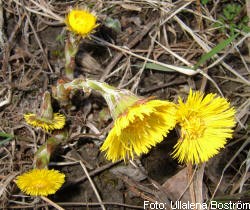Project manager: Lars Andersson, Department of Crop Production Ecology, SLU
The main aim of this project is to devise an effective control strategy for coltsfoot through studying the effects of varying timing and intensity of mechanical break-up and/or ploughing in of rhizomes under different competitive conditions. To achieve this, we have established the following sub-objectives:
Determine the compensation point for growth for different degrees of mechanical break-up and rhizome depth, and relate this to establishment in the field.
Investigate how cultivation practices affect coltsfoot propagation and how these effects are related to compensation point and rhizome bud dormancy.
In two years of pot experiments, we will study the effects of degree of break-up and rhizome depth on plant establishment. Four lengths of rhizomes will be planted at four depths, and biomass will be harvested on five occasions. The weight of aboveground and belowground biomass will be used to calculate the compensation point.
In two years of field experiments at two sites, we will investigate how different combinations of rotavation, stubble cultivation, ploughing date and competition (with and without spring-sown crop) affect coltsfoot. The experimental treatments (with and without spring crop) will comprise:
-
A. Control (no soil cultivation)
-
B. One stubble cultivation + early autumn ploughing
-
C. Two stubble cultivations + late autumn ploughing
-
D. Two stubble cultivations + spring ploughing
-
E. One stubble cultivation + early autumn ploughing + rotavation in spring
